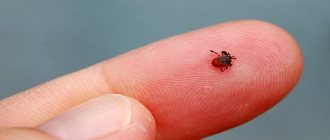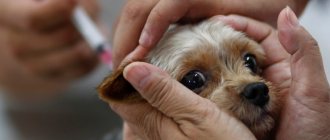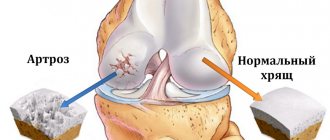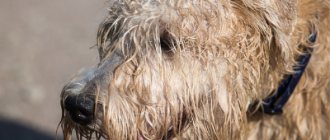Content
1. Rabies - definition 2. Possible routes of infection 3. Features of the incubation period 4. Symptoms and signs indicating that a dog is infected with rabies 5. How can rabies be detected in an animal 6. Is it possible to cure rabies 7. Basic preventive measures, organization of treatment 8. Correct solution 9. Video
Rabies in dogs is a dangerous viral disease that is practically untreatable and, after the appearance of characteristic symptoms, almost always ends in death. The deadly virus is transmitted through a bite or close contact between animals, and people are also at risk.
The dog owner should know all the main symptoms of rabies in the dog, as well as the procedure to follow if any suspicion arises. Delay in this case is unacceptable, since not just the health of the animal is at stake, but also its very life. In addition, any dog owner should be able to take first aid measures for people bitten by an infected dog. Whether a person gets sick directly depends on correct and timely exposure!
How to test a dog for rabies?
If a dog owner sees symptoms of a pet being infected with a terrible disease, the following measures need to be taken:
- Isolate the animal from other relatives and people.
- Take him to the clinic. Unfortunately, for living creatures there are no accurate methods for determining rabies in a dog. The doctor places the animal in quarantine for 10 days and observes its behavior. No tests are performed on living dogs for this disease, since the four-legged dog poses a threat to clinic workers. If during the quarantine period rabies symptoms in dogs show obvious symptoms, the animal is euthanized so as not to prolong its suffering. No treatment is provided, even to alleviate the condition. An accurate diagnosis is made posthumously.
Testing for rabies in dogs
There is no exact answer to the question of how to understand that a dog has rabies. In addition to the violent form with obvious symptoms, a pet can also suffer from a silent version of the disease and be a virus carrier. It is important to monitor your pet and changes in its behavior, especially if there is an episode of communication with a suspicious mammal. A rabies test is taken from a dead animal if it has bitten someone. To do this, you need to deliver his corpse or head to the laboratory. The diagnosis is confirmed by brain examinations for the presence of Babes-Negri bodies in the microscope field.
Rabies - definition
Rabies in dogs is a viral infectious disease that occurs in an extremely severe form and is characterized by progressive damage to the brain, spinal cord, central nervous system and, in the vast majority of cases, leads to death. It is possible to counteract a deadly virus only if the very first symptoms of the disease are identified in a timely manner and all necessary countermeasures are taken.
The most important responsibility of every dog owner is to know and be able to distinguish the slightest signs of a viral disease.
There are the following main types of virus:
| Street (Wild) | It is he who poses the greatest danger, circulating and being transmitted from one individual to another in the natural habitat of animals (primarily dogs). |
| Fixed | It does not cause disease and is used by doctors to develop and obtain an antidote - special vaccines. |
The virus multiplies first in the cells of the medulla oblongata, then spreads to the lumbar back and affects the entire central nervous system of the dog. The causative agent is a specific RNA; it can spread everywhere, maintaining its activity and danger at low temperatures, as well as under the influence of a number of chemically active substances and drugs.
What can definitely destroy the virus is high temperatures; the resistance of hydrophobia is sharply lost under the influence of direct sunlight.
Possible routes of infection
Almost every dog can get rabies, regardless of age, breed, or good health.
At risk are:
- Unvaccinated dogs.
- Small puppies whose immune systems have not yet developed.
- Exhausted creatures weakened by other diseases;
- Individuals living in areas where unfavorable conditions have been recorded precisely due to the widespread spread of the rabies virus.
- Animals living in close proximity to forests and capable of contact with wild animals.
There is an increased risk of “catching” a deadly disease in hunting dogs, including those who take part in hunting foxes, hares, animals living in minks, etc.
As a rule, the rabies virus enters the dog’s body along with the saliva of a sick animal that is a carrier of the disease. Most often, when a healthy dog is bitten by a sick individual.
IMPORTANT!: A rabid dog becomes contagious immediately after it itself has been infected with the virus. It remains extremely dangerous at any of the other stages of disease progression.
During the incubation period, only experienced specialists and attentive owners who take responsibility for the health of their pet are able to clearly identify the problem and organize measures to counter the spread of the disease and cure the infected dog. Infection with rabies can also occur if the saliva of a sick animal gets into a wound, a deep crack in the skin, or onto the mucous membrane of internal organs.
If a pet has not been vaccinated in a timely manner or has not been vaccinated against rabies, it automatically falls into a high-risk group. If infected, such a dog has practically no chance of survival; death is guaranteed. Therefore, you should not wait for the manifestation of any symptoms; the recommendations of experts are clear: it is necessary to carry out periodic vaccination in accordance with the established timing and frequency.
Dog owners should be aware of the fact that the incubation period for rabies occurs with virtually no symptoms, and at the end of it there is a sharp activation of the virus, its accumulation in saliva (one of the reasons for increased salivation) and a sharp manifestation of all the main adverse signs of damage to the nervous system, musculoskeletal system. the animal's locomotor system.
Can a domestic dog become infected with rabies and how does it happen?
Can a pet dog get rabies? Unfortunately yes. Transmission of the virus usually occurs through physical contact between a carrier and a healthy animal. Rabies penetrates the spinal cord and causes inflammation of brain tissue in stages 2 or 3 of the disease. However, the rabies virus penetrates the salivary glands much earlier than its clinical signs appear.
The highest concentration of the rabies virus is found in saliva and is transmitted when an infected animal bites a healthy one . Other methods of transmission include scratches and contact with infected blood or saliva. Hypothetically, infection can occur if the saliva of an infected animal comes into contact with the broken skin of a healthy animal.
Note! It has not been scientifically proven, but it is believed that a healthy animal can become infected by inhaling fumes generated from the rotting of a deceased infected animal.
Features of the incubation period
A distinctive feature of the onset of the disease is the almost complete absence of any obvious or indirect signs and symptoms. A natural focal infection of the viral type, having entered the animal’s body, is in no hurry to show itself and gradually “accumulates strength.”
The incubation period for this infection does not have a clearly limited time frame and in this way it is similar to many other types of inflammatory viral diseases. On average, it may not be possible to recognize the onset of the disease within 21-42 days. And only after the incubation period has passed, the main symptoms of the disease begin to appear. As noted earlier, unfortunately, after irreversible processes have started in the body. That is why the owner of the animal needs to firmly know and memorize all the obvious and hidden symptoms of the virus.
Of course, the main way of contracting rabies is a bite. But if there are open wounds on the surface of the animal’s skin, they can become the weak point in the body through which the harmful virus penetrates.
Follow us
Find out more about your animal's personality on our social networks
Puppies become infected most quickly; the rabies virus can appear in them as early as 4-6 days of infection.
Adults with strong immunity are able to retain the virus for 2 or even 3 months. But in any case, if there is no vaccination and no treatment and preventive measures are taken, no immune system can cope with the rabies virus on its own.
Why does the infection affect young dogs and puppies faster? Everything is very simple. The virus belongs to the encephalitic category and moves through the body’s neural system at a clearly fixed speed - about 3 mm per hour. It is obvious that the total length of neural circuits in small, young dogs is shorter compared to older, stronger individuals. Accordingly, the disease in large, adult dogs comes out a little later.
Symptoms and signs that indicate your dog is infected with rabies
1.
Infection with the rabies virus in a dog manifests itself completely differently than standard, common types of infectious diseases. First of all, the psyche and behavioral characteristics of the dog change. Initially, the animal begins to behave as if it had done something wrong to its owner. The dog bows his head down, his gaze becomes meek, sad, tired. He stops frolicking and playing, tries to sort of retire, avoids contact with people and any other living beings.
Prolonged lying down is the first dangerous symptom that you should pay attention to.
2.
Another indirect sign indicating that the virus has entered the dog’s body is constant thirst. The animal drinks a lot of water, much more than the body requires. By drinking sufficiently large volumes of water, the dog does not experience the same feeling towards food. As a rule, she does not want to eat, and if she does eat any food, its volume remains negligibly small compared to the standard daily diet. In some cases, the animal retains its appetite not only during the incubation period, but also at the moment when the disease begins to manifest itself. The peculiarity of eating is difficulty swallowing food, the dog seems to be choking, but it does not swallow large pieces.
3.
It is worth paying close attention to the behavior of your pet during daily walks. If a dog tries to eat stones, chew wood, tree bark and other objects that are not suitable for ingestion, measures should be immediately taken to diagnose the health condition and, if necessary, treatment.
Remember the following symptoms that may indicate rabies infection and the incubation period in your pet:
- Continuous diarrhea.
- Voice change. He becomes hoarse, hoarse, and over time the situation only gets worse.
- Even in the warm season, the animal may experience severe chills and trembling that spread throughout the body.
- The dog becomes unstable, poorly controlled, disobedient, irritability, fussiness, and restless behavior are evident.
- The dog cannot tolerate bright daytime conditions, especially direct sunlight, and strives for solitude in the dark.
- The fur begins to fall out profusely and this process occurs outside of molting.
Further, when the incubation period is over, the disease comes out and the symptoms of rabies become obvious. The virus has infected the animal's brain and it becomes uncontrollable. Inappropriate behavior, loss of self-control and outbursts of aggression indicate obvious progression of the disease.
The active stage of rabies is characterized by the following symptoms:
- The animal not only avoids water (ponds, puddles, etc.), but experiences uncontrollable fear, real panic;
- Foam and saliva flow from the mouth profusely and uncontrollably (the process of salivation is accompanied by a characteristic evil grin, often distorting the usual, even the most aggressive, features of the expression of the animal’s muzzle in its normal state);
- The dog tries to constantly gnaw his paws, bites his tail;
- Aggressive behavior is possible, accompanied by attacks on other animals and even people.
Immediately before death, the dog stops showing aggression, having neither the strength nor health to do so. The virus completely affects the central nervous system and immobilizes the animal. The hind legs are taken away, and paralysis gradually approaches the brain. Next comes death.
Dog rabies
Rabies (Rabies. Lyssa, Tollwut, La Rage) – hydrophobia, hydrophobia, is an acute viral disease that occurs with severe damage to the nervous system, usually with a fatal outcome.
Historical reference. Rabies has been known to humanity since ancient times. Thus, animal rabies is mentioned in the works of Aristotle, Democritus and others. At the beginning of the 1st century AD, Celsus described rabies in humans, calling it hydrophobia. L. Pasteur developed a method of preventive vaccinations against rabies, for which he used an experimentally obtained version of the virus (fixed virus). In 1887, Babesh discovered special inclusions in the protoplasm of neurons in the brains of rabid animals. A. Negri in 1903 gave them diagnostic significance, and since 1950. they began to be called Babes-Negri bodies; they are conglomerates of accumulations of viral and intracellular matter.
Rabies today has great social significance due to the threat to human life.
In the last decade, there has been a widespread spread of rabies among wild animals - foxes, raccoon dogs, etc.
Etiology . The causative agent of rabies is a large RNA-containing neurotropic virus from the genus Rhabdovirus. When examined by electron microscopy, the elementary particles (virions) of a street virus have the shape of a rod, one end of which is rounded, the other is flattened (bullet shape). The transverse diameter of the particles is 70-80 nm, the length is about 180 nm. Moreover, the virions of the fixed virus are shorter - 100-150 nm. The nucleocapsid has helical symmetry. In the body of a sick animal, the virus multiplies and accumulates mainly in the gray matter of the brain. The rabies virus is characterized by the formation of Babes-Negri bodies in the cytoplasm of nerve cells of the central nervous system. These bodies are formations of various shapes (round, elliptical, pear-shaped, ovoid or angular-triangular) ranging in size from 0.25µ to 27µ in diameter. One cell can contain from 1 to 6 bodies of various sizes. Long-term passages in chicken embryos help reduce the virulence of the virus. Passaging a street virus on rabbits, through successive subdural passages, Pasteur, Chamberlan and Roux managed to obtain a virus with new, fixing properties, not pathogenic for humans and animals.
Epizootological data . From ancient times until the 18th century, rabies was primarily a disease of wild animals (“forest rabies”) that infected farm animals and humans. With the development of civilization and the emergence of large cities, rabies moved to populated areas. After the Second World War, rabies again moved into forests and became a new “forest-type rabies”, affecting mainly wild animals and animals in rural areas.
There are two types of rabies outbreaks. The first type - natural, or forest, which is supported by wild animals, is often not registered until rabies takes on the character of an enzootic. The second type is urban; its development is directly dependent on the number of stray and stray dogs in populated areas; in addition, rats and mice, which are widespread in populated areas, play a role.
In the last 10 years, in Russia, despite the widespread use of the Oralrabivak vaccine in hunting farms, there has been the greatest spread of “forest rabies” among wild animals. Foxes and raccoon dogs with rabies, having lost their sense of fear, go to populated areas, especially those located in close proximity to forests, enter into battle with domestic dogs, which fearlessly attack uninvited “guests”, guarding the territory entrusted to them, and become infected with the rabies virus .
Infection with rabies under natural conditions occurs only when the saliva of a rabid animal comes into contact with damaged skin or mucous membrane, mainly through a bite. Dog bites are especially dangerous due to the fact that their saliva contains the enzyme hyaluronidase, which has the ability to quickly increase tissue permeability to the virus.
Dog owners should remember that the saliva of an infected animal may contain the rabies virus several days (4-10) before the characteristic clinical signs of rabies appear. The possibility of a dog becoming infected with rabies is directly dependent on the content of a sufficient amount of virus in the saliva of a sick wild animal (fox, raccoon dog, etc.) at the time of the bite. The most dangerous are bites in areas rich in nerve endings (nose area, lips), the number of bites and their depth.
Pathogenesis . Once the rabies virus enters a dog's body through a bite, it binds to the nerve cells, causing their damage. The rabies virus spreads along centripetal nerve fibers to the place of its reproduction and accumulation - the central nervous system. Due to the fact that small blood vessels are damaged when bitten, the possibility of the virus spreading through the blood and lymph cannot be ruled out. Having penetrated the brain, the rabies virus, simultaneously with its reproduction and accumulation in it, begins its downward movement along the centrifugal nerve pathways to the peripheral nerves that innervate all tissues and organs, including the salivary glands, affecting the nerve nodules of the salivary glands (lying superficially under the mucous membrane tongue and cheeks), where it reproduces. As a result of infection by the virus, the cells of these nerve nodules degenerate, are destroyed, and the rabies virus passes to the surface of the mucous membrane or into the salivary duct of the gland. The rabies virus can be detected in saliva 5-10 days before the first clinical signs of the disease appear in the dog. Based on this fact, a 10-day observation period has been established for dogs suspected of the disease (having bitten people and animals).
Reproduction of the virus in the brain initially causes irritation of nerve cells, which leads to the development of diffuse non-purulent encephalitis, manifested by increased reflex irritability and aggressiveness of the sick dog. Then, as a result of degenerative and necrotic changes in the central nervous system, the dog develops paralysis. With severe lesions, the dog experiences paralysis of the respiratory or cardiac organs, which ultimately leads to its death. In a few cases, the infectious process seems to stop, and recovery occurs. This should be considered as a consequence of the developed immunity suppressing the pathogenic effect of the virus.
Immunity . Natural immunity in susceptible animals is observed in exceptional cases. Immunity against rabies can only be acquired after vaccination. To immunize animals, inactivated vaccines are used, in which the virus is neutralized by various chemicals: phenol, formaldehyde, glycerin and phenol.
Clinical picture . As a rule, rabies is transmitted to dogs through saliva when bitten by animals with rabies. For dogs, the most dangerous bites are from rabid wolves, which cause deep and lacerated wounds, which contributes to a large infection. About 1/3 of animals (and people) bitten by rabid animals become infected. This fact is explained by the protective effect of the coat (or clothing), and on the other hand, by the natural resistance of the body.
The incubation period in dogs varies widely. Usually it ranges from 3 weeks to 3 months. In some cases, signs of the disease may appear after 7-8 days or after several months. The length of the incubation period in a dog depends on the location of the bite, the amount and virulence of the virus, the age and general resistance of the infected dog. Young dogs have a shorter incubation period than adults. The shortest period occurs with a bite to the head area.
In dogs, rabies usually manifests itself in two forms: violent and silent .
The violent form of rabies in dogs manifests itself in three sequential stages, but sometimes dogs with rabies may not go through all these stages.
1. Prodromal or melancholic stage. Quiet form. It occurs in dogs within 12 hours or 3 days. At this stage of the disease, dog owners note a change in the usual behavior of their pet. The dog becomes boring, apathetic, capricious, avoids people, tries to hide in a dark place, and is reluctant to respond to the owner’s call. Subsequently, the dog becomes anxious, restless and irritable. She develops increased sensitivity to noise and light, anxiety and excitability gradually increase. Then suddenly the dog experiences a change in behavior - the dog exhibits its usual behavior, cuddles up to its owner and family members, tries to lick its face and hands. Previously withdrawn dogs become more sociable, and sociable ones, on the contrary, become aggressive. May become depressed or attack other animals without warning. The dog often lies down and jumps up, barks for no reason. Dog owners register increased reflex excitability (to touch, light, noise, rustle); In the game, the dog may bite the owner's hand, showing its displeasure. Some sick dogs nervously walk in circles, dig the ground near the kennel, constantly listen warily to something, and begin to catch invisible flying objects with their teeth ("fly catching" syndrome). Sometimes the dog owner notices spontaneous urination and increased sexual desire. At the onset of the disease, during a clinical examination, the veterinarian registers an elevated temperature of up to 40-41 ° C, the pupils are dilated, and the corneal reflex is weakened. We notice shortness of breath in the dog. In some dogs, severe itching appears at the site of the bite; the dog scratches, licks, and sometimes chews the site of the bite. As the disease progresses, the dog develops a perverted appetite, accompanied by eating inedible objects (sticks, stones, glass, own feces, etc.); The owner of the dog notes a change in food intake, which manifests itself in the fact that the dog may throw taken meat out of its mouth or refuse treats altogether. At this stage, the dog begins to develop paresis of the pharyngeal muscles - accompanied by difficulty swallowing (outwardly manifested by difficulty swallowing), drooling, hoarse and jerky barking, an unsteady gait, and sometimes squint.
Exuberant form . The period of excitement in this form in a dog appears 1-3 days after the initial stage of the disease. All of the above symptoms of prodromal stage rabies in a sick dog intensify, and the anxiety and excitement that appears in the animal as a result of the onset of hallucinations drive the dog to madness.
In this form, a dog’s aggressiveness increases; such a dog, without any reason, can bite any nearby animal, as well as people. They gnaw all inedible objects (sticks, iron, earth, etc.), tear them into pieces, breaking their teeth, and sometimes the lower jaw. It is characteristic that such a dog silently runs up to animals and people, biting them. Such dogs have an increased desire to break free from the chain and run away. Having broken free from the chain, such a rabid dog runs several tens of kilometers in a day, biting other dogs, animals and people along the way. During a clinical examination, a veterinarian will diagnose the dog as having disorientation (absent expression in the eyes). Such a rabid dog has no sense of fear at all; the symptom of aggression dominates over other signs of rabies. Emerging attacks of violence, which last for several hours, are replaced by periods of depression, during which the dog lies motionless, after which the dog can stand up, staggering, with a detached expression in the eyes. After each attack of violence, the dog experiences a period of oppression and depression, which continues until the dog is exposed to the next stimulus.
During a clinical examination, a veterinarian notes the appearance of symptoms of paralysis - a characteristic shrill bark, which, due to damage to the vocal cords, can turn into a high-pitched, drawn-out howl, which is of great diagnostic value. Upon examination, the specialist notes muscle tremors, poor coordination of movements, and the dog’s lower jaw droops as a result of paralysis. The oral cavity of such a dog is always open, the tongue falls half out of the mouth, and we note profuse salivation.
The dog refuses both food and water. The entry of any irritants into the oral cavity leads the dog to attacks of suffocation and rage; Often one type of water can cause a dog to choke. At the same time, the dog experiences paralysis of the swallowing muscles and tongue muscles, as a result of which the dog cannot eat the food offered to it. In such a dog, owners note spontaneous bowel and bladder emptying. The veterinarian notes uneven dilation of the pupils, mild squinting, unsteadiness of the rear, and the tail is usually drooping.
The arousal phase in a dog lasts from 2 days to a week. After which the dog has a third.
the last stage is paralytic or depressive , which lasts 1-4 days. Paralysis in a rabid dog extends to most of the body. In a sick dog, in addition to paralysis of the lower jaw, paralysis of the hind limbs, muscles of the tail, bladder and rectum occurs, and lastly, paralysis of the muscles of the trunk and forelimbs occurs. If the body temperature of a sick dog in the excited stage rises to 40-41°C, then in the paralytic form it decreases below normal. The dog's gait becomes unsteady, the tail is drooping, and the dog appears exhausted in appearance. Such a dog no longer shows violence, it is severely depressed and practically cannot move. At the same time, the consciousness of such a dog is preserved to some extent; it can react to its name, even to the point that it will try to carry out the owner’s commands. The subsequent muscle incoordination and convulsions lead to generalized paralysis. The death of the dog occurs on the 6-7th day with general paralysis and severe exhaustion. When examining the blood, we have polymorphonuclear leukocytosis, a decrease in the number of leukocytes. The sugar content in urine increases to 3%. The total duration of the disease is 7-10 days, while the death of a dog from rabies can occur within 3-4 days.
Experts have noticed a peculiarity when, in the silent (paralytic) form of rabies (which often occurs with bites from rabid foxes), excitement in dogs is weakly expressed or completely absent. In such rabid dogs, with a complete lack of aggressiveness, experts register severe drooling and difficulty swallowing. Therefore, the owners of such an animal should not attempt to use flattery in the mouth in order to remove a non-existent bone, as they themselves may become infected with rabies through saliva.
Pathoanatomical changes . The corpse of a dog that died from rabies is emaciated, the fur of the head, neck, dewlap, and front legs is moistened with saliva. There are numerous injuries on the skin - the result of fights with other animals, violence, and self-scratching. The mucous membrane of the oral cavity is hyperemic, with the presence of ulcers and erosions. We register some dryness of the subcutaneous tissue and muscle tissue. Internal organs are hyperemic, sometimes with the presence of parenchymal degeneration and minor hemorrhages. The dog’s stomach is empty, but (this is considered typical) inedible objects are found in it - sticks, stones, bedding, etc. There are hemorrhages and congestive hyperemia in the gastric mucosa. When opening the skull, we find some tension in the dura mater, cloudiness and swelling in the soft mater. The cerebral convolutions are smoothed, the pinkish color of the nervous tissue is enhanced on the section, and small hemorrhages are found. The nervous tissue is somewhat softened. There is a large amount of exudative fluid in the lateral ventricles and spinal canal. The choroid plexuses are heavily injected and swollen. Histological examination of the brain always establishes diffuse non-purulent encephalitis. Leukocyte and lymphocytic infiltration, neurophagia, and a proliferative reaction on the part of glia are well expressed. Muff-shaped perivasculitis “rabies nodules” and multiple microhemorrhages are found. We find various types of formations in the form of nodules and inclusions, namely: B. Babes nodules, acidophilic grains, Babes-Negri inclusion bodies. These inclusions are more often found in the cells of Ammon's horn. They can be found in nerve cells and other parts of the central nervous system: in the cerebral cortex, cerebellum, medulla oblongata, etc.
The diagnosis of rabies by a veterinary specialist is established comprehensively on the basis of epizootic, clinical, and pathological data with mandatory confirmation by the results of laboratory tests. The veterinarian takes into account the disadvantage of the area with rabies, medical history (fact of a bite) and characteristic clinical signs of the disease (excitement, aggressiveness of the sick dog, drooling and paralysis of the muscles of the larynx and pharynx, lower jaw, and subsequently the limbs and torso).
For laboratory diagnostics, the head of a dead dog is sent to the laboratory. In the laboratory they carry out; microscopic examination of the brain to detect Babes-Negri bodies; diffuse precipitation reaction in agar gel - to detect specific rabies antigen in the brain; luminescent antibody method - to detect a viral antigen that has reacted with luminescent rabies serum (globulin); immunofluorescent study of corneal imprints and biological tests on white mice or rabbits.
Differential diagnosis . When conducting a differential diagnosis, a veterinarian must exclude Aujeszky's disease, the nervous form of plague, and listeriosis.
Treatment . There is no treatment for rabies in dogs. If you suspect your dog has rabies, the owner must urgently call a veterinarian, after placing it in an enclosure where it is excluded from contact with other animals and people.
Control and prevention measures . Measures for the prevention and elimination of animal rabies affect a significant range of special services, institutions, organizations, public associations, regardless of their subordination and forms of ownership, officials and citizens and are based on the implementation of Sanitary Rules SP 3.1. 096-96, Veterinary Rules VP 13.3. 1103-96.
In particular, according to paragraph 4 “prevention of rabies in animals and humans” of the above rules, managers of livestock farms, enterprises, institutions and citizen animal owners are obliged to:
4.1. - comply with the rules for keeping dogs, cats, fur-bearing animals and predatory animals established by the local administration.
- deliver dogs and cats belonging to them within the time limits established by the local administration, as provided by the chief state veterinary inspector of the district (city), to veterinary medical and preventive institutions for examination, diagnostic studies and preventive vaccinations with rabies vaccine;
— register the dogs they own in the manner established by the local administration;
- do not allow dogs that have not been vaccinated against rabies into personal yards, farms, herds, flocks, herds;
— take measures to prevent wild animals from entering herds, flocks, herds, and livestock buildings; for this purpose, graze farm animals and keep them on farms, feedlots, and summer camps under constant guard using dogs vaccinated against rabies;
- immediately inform the veterinarian serving the farm (settlement) about suspected animal disease with rabies and cases of biting of farm animals and domestic animals by wild predators, dogs, cats, take the necessary measures for the reliable isolation of animals suspected of the disease or bitten.
4.2. Dogs, cats and other animals that have bitten people or animals (except those clearly suffering from rabies) must be immediately delivered by the owner or a special team for catching stray dogs and cats to the nearest veterinary hospital for examination and quarantine under the supervision of specialists for 10 days.
4.3. In some cases, with the permission of a veterinary medical institution, an animal that has bitten people or animals may be left with the owner, who has issued a written undertaking to keep this animal in an isolated room for 10 days and provide it for examination within the time frame specified by the supervising veterinarian .
4.5. At the end of the quarantine period, clinically healthy animals after preliminary vaccination can be returned to their owners, provided they are kept in isolation for 30 days. Animals infected with rabies are destroyed.
4.6. The procedure for keeping, registering and recording dogs and cats in populated areas is determined by the local administration. Specialists from veterinary and sanitary-epidemiological services monitor compliance with this order.
4.7. The rules of keeping necessarily stipulate that service dogs outside the territory of the farm (enterprise, institution) to which they belong must be on a leash. Without a leash and muzzle, it is allowed to keep dogs in herds, flocks, herds of farm animals, during training and hunting, at educational training sites, and during the operational use of dogs by special organizations.
4.8. Dogs found on the streets and in other public places without an accompanying person, and stray cats are subject to capture.
4.9. The procedure for catching these animals, their maintenance and use is established by the local administration.
4.11. The sale, purchase and export of dogs outside the region (territory, republic) is permitted if there is a veterinary certificate, form No. 1, with a note on the dog’s vaccination against rabies.
5.4. A populated area or part of it, a forest area, a pasture, etc., where a case of animal rabies has been identified, is declared unsafe on the basis of the Resolution of the Governor of the region.
5.5. According to quarantine conditions, dog and cat exhibitions, breeding and training of dogs are not allowed in a locality unaffected by rabies. The trade in pets is stopped, the export of dogs and cats outside the troubled area and the capture (for export to zoos, for the purpose of resettlement in other areas, etc.) of wild animals in quarantined areas and in endangered zones are prohibited.
5.13. Quarantine is lifted by decision of the Governor after two months from the date of the last case of rabies in animals, subject to the implementation of planned anti-epizootic and preventive measures.
Prevention . The only measure to prevent rabies in dogs is to vaccinate dogs against rabies.
Considering the special danger of rabies for humans, mandatory vaccination against rabies in dogs is regulated at the state level. All state veterinary institutions are provided with rabies vaccine at the expense of the federal budget. Vaccination in state veterinary institutions for dogs is provided free of charge. Dog owners should be aware that vaccination against rabies is mandatory:
- if you and your dog participate in exhibitions and competitions;
- when crossing the state border of the country;
- when traveling by plane or train;
- when moving from one region to another;
- during breeding, when keeping dogs;
- Hunting dogs must also be vaccinated.
In recent years, due to cases of veterinary specialists contracting rabies in veterinary clinics, due to direct contact with rabid animals, veterinary specialists will not accept you if there is no rabies vaccination stamp in your dog’s passport.
Vaccination against rabies is carried out for dogs at 2.5-3 months of age. If the dog owner decides to vaccinate against rabies before 3 months, then in order to create intense immunity, revaccination is carried out after 14-21 days. Dog owners, when going to a veterinary clinic with their pet, should know that vaccinations are carried out only for clinically healthy animals. 7-10 days before vaccination, you will need to deworm your pet. What are the contraindications for rabies vaccination in dogs?
- increased body temperature;
- the presence of one or another helminthic infestation;
- internal organ disease
- immunodeficiency state of the animal's body
- Puppy exhaustion, underweight or developmental delay
In Russia, the following vaccines are used to vaccinate dogs against rabies:
- “Rabican” is made in Russia from the “Shchelkovo-51” strain. This vaccine is the most common and is provided to almost all state veterinary institutions at the expense of the federal budget. Dogs are vaccinated from 2 months of age. With a single immunization, immunity in a vaccinated dog lasts for 1 year, with a 2-fold immunization for 2 years.
- “Rabix” produced by Vetbiohim LLC. This vaccine is administered to puppies 2 times from 8-12 months of age and to adult dogs not previously vaccinated against rabies. The interval between vaccinations is 21-28 days.
- “Multikan-8” produced by Vetbiohim LLC.
- “Asterion” DHPPiLR LR produced by Vetbiohim LLC.
- “Depentavak” produced by JSC.
Additionally, veterinary clinics use imported vaccines to vaccinate dogs against rabies:
-Nobivak Rabies made in Holland. This vaccine helps develop immunity for up to 3 years. The vaccine is administered once at 3 months of age, revaccination is carried out a year later. In endangered areas, dogs are vaccinated 2 times: 8 weeks and 3 months.
"Defensor 3" made in the USA.
"Rabisin" produced by "Merial" France. This vaccine creates immunity against rabies for up to 36 months.
"Biocan R" , produced by Bioveta, Czech Republic. First vaccination at 3 months of age, revaccination a year later.
Additionally, veterinary clinics use complex imported vaccines that include rabies antigen.
Nobivak RL produced by Intervac, Holland.
"Eurikan DHPPI2 - LR" produced by Merial, France.
"Bican DHPPi + LR" (Bioveta, Czech Republic).
“Hexadog Hexadog” produced by Merial, France.
"Primodog" produced by Merial, France.
Issues of preventing rabies in humans and the methodology for examining dogs for rabies are outlined in the corresponding article on our website.
How can you detect rabies in an animal?
Rabies can only be 100% recognized by blood tests. This is the procedure that must be carried out in a veterinary clinic for any of the above symptoms. Here, responsibility for the health and life of the animal lies entirely with the owner. Inattention and irresponsibility are unacceptable. For the period of time while a clinical study of data and blood processing is being carried out, the animal must be placed in an isolated enclosure, where there is no contact with people or other animals.
In the same way, you can check whether your dog is infected without doing a blood test. To do this, the animal is kept in an enclosure for about 2 weeks and its condition is constantly assessed for compliance with or manifestation of any symptoms from those listed earlier. Of course, the second method will not save the pet’s life, but will only protect other animals and people from becoming infected with the most dangerous viral disease.
Blood test for rabies - how and where to take it
If uncharacteristic signs appear in animals, it is recommended to immediately contact a veterinary clinic and have the dog checked for the presence of the virus.
Before making a primary diagnosis, the medical history, symptoms, and epizootological situation are taken into account. Several laboratory and other tests are carried out, express analysis, biological material is studied under a microscope. A discriminating diagnosis is carried out in order to exclude infections with similar symptoms.
If a person is bitten by a dog, he is isolated for 10 days. While the tests are being prepared, she is being monitored. If the disease is confirmed, the dog is euthanized.
An accurate diagnosis can be made after death: pathological material is obtained and examined using various techniques.
The most effective method is to study the biomaterial under a microscope for the presence of Babes-Negri bodies. To detect a specific antigen in the brain, a diffuse precipitation reaction and immunofluorescence analysis of the corneal imprint are used. The immunofluorescence method is capable of detecting antigen in 93% of cases.
Because the virus travels along nerve pathways, it is difficult to detect in the blood. Cerebrospinal fluid is usually examined. Nevertheless, a general and biochemical analysis of the dog’s blood is performed to study changes in leukocytosis, oliguria and other indicators. Blood is taken from veins, which are located in the same place as in humans. Sometimes an animal's saliva is tested.
A test for the presence of rabies antibodies in the blood can be done in accredited laboratories (less often in veterinary clinics). Its cost is high, the results are ready after two to three weeks. There are two types of test RFFIT (rapid fluorescence focus inhibition) and FAVN (determines antibody titer in IU/ml).
Usually the test is carried out when transporting an animal abroad (some states prohibit the import of animals that have not been vaccinated against rabies). A test for antibodies to rabies is given only after the production of antibodies to this infection in the blood. Immunity to the disease develops no earlier than 30 days after vaccination. After this period, the pet can take a rabies test.
If the amount of anti-rabies antibodies does not reach 0.50 IU/ml, the animal is revaccinated, and a month later another test is taken. The production of protective antibodies is influenced by the breed, age of the pet, and individual characteristics. Doctors recommend monitoring the amount of antibodies after vaccination.
Can rabies be cured?
No! Despite the fact that the antidote and the technique have been developed for hundreds of years, there has been no effective progress in this matter; the disease continues to manifest itself in cases where conditions are created for this (contact with an infected animal or an animal that is a carrier of a dangerous virus.
All that medicine has achieved in this direction is to develop an effective vaccine that can resist the disease. The vaccinated animal, of course, will get sick after the bite, but it will still have every chance of staying alive and completely restoring the normal functioning of all organs.
What to do if a dog bites a person
Rabies is just as deadly for humans as it is for animals; after a bite, a certain algorithm must be followed.
First aid rules:
- If the wound is shallow, you need to let the blood flow freely to wash away as much of the virus as possible.
- Wash the wound with a 10% solution of laundry soap; the procedure should be carried out within an hour after the injury. Rinse the affected area for at least 5 minutes, pour the solution under pressure.
- In case of severe bleeding, apply a tourniquet.
- Treat damaged tissues with peroxide, alcohol, iodine, Miramistin, Chlorhexidine, apply a bandage of sterile materials, and go to the emergency room.
- The doctor administers specific immunoglobulins before vaccination.
- Previously, against rabies they gave 40 injections in the stomach, now the course is much shorter - 6 vaccines are given in the forearm, for children under 5 years old - in the thigh.
- Vaccines are administered to children and pregnant women; the dosages are always the same.
Rabies injections for a person after a dog bite are always prescribed, even if the animal is domestically vaccinated.
Doctors recommend preventive immunization for people not only if they are bitten by a dog, but also if the animal’s saliva gets on damaged areas of the skin.
Basic preventive measures, organization of treatment
The best and only true prevention of a possible illness is timely and regular vaccination. Each purebred dog is required to be vaccinated, and compliance with this requirement is checked at various stages, in places where the dog may come into contact with people and pets. For example, at exhibitions, before boarding a train or when transporting by plane.
The probability of a vaccinated dog contracting rabies does not exceed 2%, this is a very high figure! The vaccination process is carried out sequentially and consists of the following main stages:
- At the age of 2 months, the puppy receives its first vaccination.
- After 3 weeks, vaccination is repeated.
- We monitor the change of teeth in young animals and administer a third rabies vaccination.
Your pet can now be considered protected from the deadly rabies virus. But on one condition: the animal vaccination program must continue annually, and the vaccination is done, if possible, at the same time.
If the dog is not vaccinated, but is bitten, vaccination must be carried out as quickly as possible. The life of your four-legged friend depends on it. After administering the drug for at least 2 months, the animal should not be overloaded physically and emotionally. Overheating and hypothermia are also contraindicated. Physical and psychological fatigue of the animal are factors that can create ideal conditions for the rapid spread of the disease.










